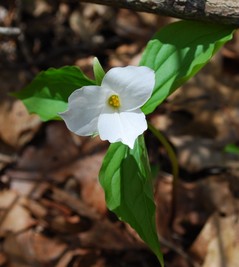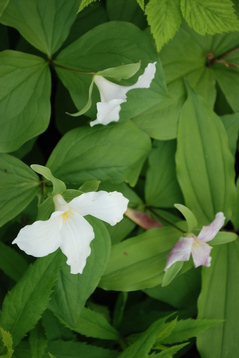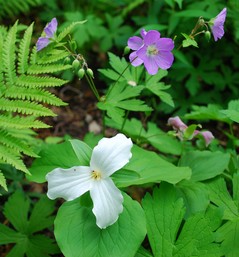Triumphant trilliums: Threes are wild!

A great white trillium (Trillium grandiflorum) flower in all its glory
Rick Meader | Contributor
In Michigan, the large white trillium (Trillium grandiflorum) is the most common and can form spectactular stands if the deer leave them alone. For deer, while they are extremely popular to see, they’re even more popular as food. As the population of deer has grown, the populations of trillium have dwindled.
Unfortunately, their popularity also has made them prey for collectors and sellers of wildflowers to folks who would like them in their own gardens. Still, there are places around the Ann Arbor area that have very impressive populations that are fun to visit, and leave behind.
According to the gospel, Wikipedia, there are about 40-50 species of trillium in North America and Asia. According to the USDA plants database, there are 39 species in North America, and Michigan has nine species we can count as native somewhere in the state. Those species are Large white trillium (Trillium grandflorum), Painted trillium (Trillium undulatum), Snow trillium (Trillium nivale), Prairie trillium (Trillium recurvatum), Toadshade (Trillium sessile), Red trillium (Trillium erectum) - also known affectionately as Stinking Benjamin or Stinking Willie, Nodding Trillium (Trillium cernuum) aka Whip-poor-will flower, Drooping Trillium or Nodding Wake-robin (Trillium flexipes), Yellow Trillium or Yellow wakerobin (Trillium luteum). Look them up.
Interestingly, trilliums are in the lily family, so they’re kin of such wildflowers as Death camus (Zigadenus venenosus) , Beargrass (Xerophyllum tenax), False Solomon’s Seal (Smilacina racemosa), Nodding wild onion (Allium cernuum), Yucca (Yucca spp.), and Michigan Lily (Lilium michiganense), among many others. Since the Great White Trillium (Trillium grandiflorum) is what is most common around here, I’m going to focus on it for the rest of this entry.

Young and old trillium blooms
Rick Meader | Contributor
As you can see in the picture here, the flower has three white petals that gradually turn pink as they age (the flower, not the plant). So, if you see a trillium with white and pink flowers, don’t think you’re seeing a rare plant (as I did when I first observed this, not knowing anything about anything) - you’re just seeing one with flowers on their last legs.
After the flower has given up the ghost, and if it was lucky enough to be pollinated, it forms a small pod with about 16 small, brown, oval, nondescript seeds that are distributed by ants that like to feast on a little oil-rich structure on the seeds called an elaiosome, so they spread slowly.
Bloodroots and Dutchman’s breeches also have these structures and are spread around by ants. The flowers and leaves sprout up from a thickened rootstock that is perennial. According to one source, the plants take from five to nine years to grow from seed to flowering plant. As a result, they’re not widely available commercially, and if you do find some, there is probably a good chance that they’ve been dug up from nature instead of grown from seed, given the long time lag until they can be sold.
If you pick a trillium flower, you could kill the plant, or at least set it back a long way, so please leave them to bloom and take a picture, but nothing else.
I always think it's fun to learn about different uses Native Americans had for different plants, and they can vary widely from tribe to tribe. For example, according to the University of Michigan Ethnobotany website, Chippewas would use it for sore ears and sore joints, while Menominees would use it for cramps and as a disinfectant. We don’t know how effective they were, or what side effects may or may not have accompanied these uses, but it’s interesting to think about their use of the woods and meadows as their local apothecary.
If you want to see these plants in their native splendor, you may see some as you drive along a country road and glance off-road to peer into the forest. Of course, this isn’t good driving advice, but you can probably spot some along Huron River Drive between Ann Arbor and Dexter.
If you want to actually walk, there is a really good population in the oak woods of County Farm Park; another good population in Montibeller Park behind the Carpenter Road Meijer; and a nice population in Nichols Arboretum in the woods south of the Dow Prairie. I understand there is a good population in Mary Doyle Park off of Packard Road in Ann Arbor, too. They like rich woods, so if you know of some, you might want to take a walk soon, as the flowers don’t last forever.

Trillium and its woodland pal wild geranium (Geranium maculatum)
Rick Meader | Contributor
Rick is a local landscape architect and Ann Arbor native, with a special interest in all things natural, including native plants and the critters who eat them. You can contact him at yourland1824@gmail.com.


Comments
Jean
Wed, Jun 16, 2010 : 12:32 a.m.
Wondering why the plant might die if the flower is picked. Obviously, if it takes 5 to 9 years to flower there are different things happening in their development cycle. Could you share your thoughts on these ideas?
Glenn Galler
Sun, May 16, 2010 : 8 a.m.
This was a very interesting piece, Rick, and very nicely written. I enjoyed it.
Rick Meader
Tue, May 11, 2010 : 10:28 p.m.
Thanks for the info, Rork. I like Phlox divaricata very much, and am lucky enough to have some in my yard. It can be purchased at Wildtype Nursery in Mason. Also, I forgot to mention that at the Dexter Garden Club's annual plant sale this weekend (from 9 to noon at Monument Park, downtown), they will have native plants for sale, and some other displays related to native plants and their use in the landscape. I understand they'll have some sample designs for different conditions available, too. So, if you want to add some natives to your landscape, visit their sale (and avoid the invasives). Rick
Rork Kuick
Tue, May 11, 2010 : 10:17 a.m.
In the Waterloo and Pinckney recreation areas, the north side of any large hill will do. It's not any better than closer to town though. I want larger areas fenced to exclude deer in every Rec area, so we can see better what the damage being done is. Similar exercises in Pennsylvania have produced flower species that the rangers didn't even know were in their areas. I've been calling woodland phlox, blue phlox I think (maybe there's some subspecies difference, but both are Phlox divaricata I think). It's a pretty new plant for me, and it is spectacular, and flowers for a fairly long time. I see it most in prairie-like settings, and it seems to like it after burns. Saw tens of thousands of wild geranium blooming in Stinchfield Woods yesterday (near the old optical observatories is good). Saw a few Lupines sunday, but it was just the very beginning.